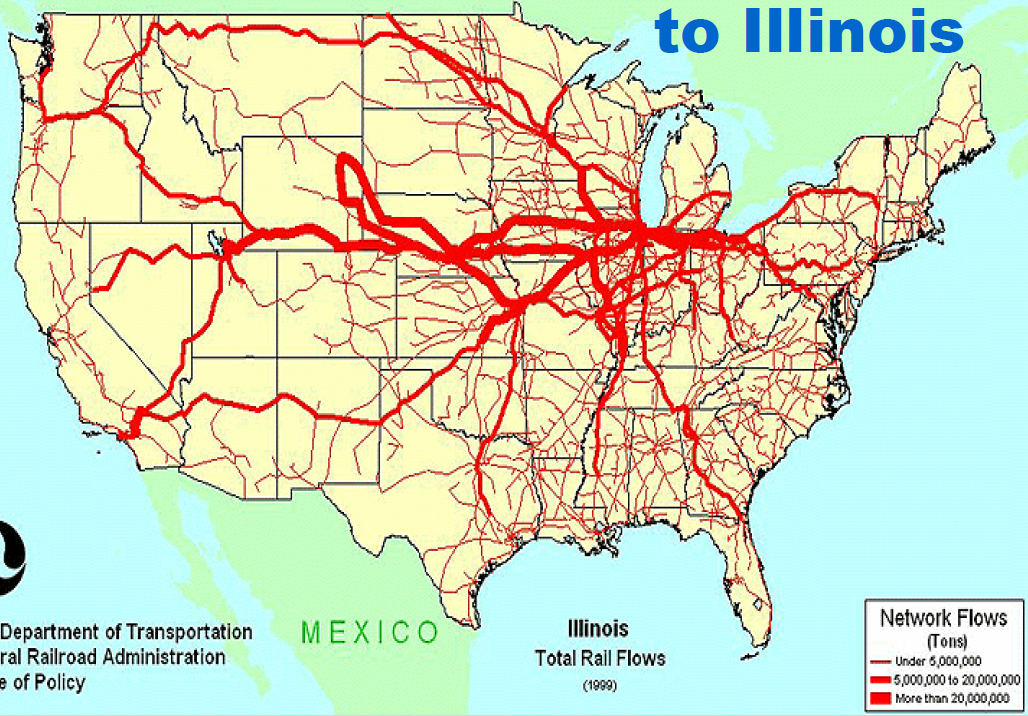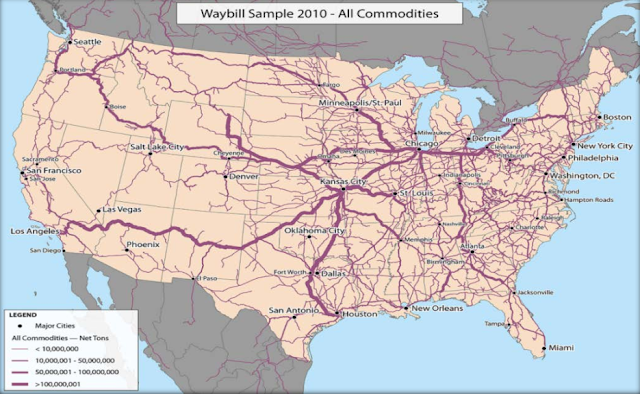<update>
Especially as the Powder River Basin coal flows decrease, the waterways carry more than the rails. And the railroads have successfully forced a lot of freight traffic onto our highways.
 |
| bts.gov |
</update>
The thick line from Southern California to Chicago would be over the BNSF/SantaFe route. Looking at the system maps of NS and CSX, it appears the transcontinental traffic is handed off to NS. This is probably because of their competitive advantage of the Streator, IL cut-off. This traffic flow would explain the BNSF/NS merger noise I have been seeing on the web. It will be interesting to see how thin this line becomes once the Panama Canal enlargement project is completed.
The flow from Salt Lake to Chicago shows how important the Chicago and NorthWestern route is for the Union Pacific. The former Burlington Northern route between Seattle and Chicago is also an important corridor. The major surprise is that most of the San Francisco Bay traffic goes via Southern California rather than use the former Southern Pacific route to the east.
Evidently NS plans for their Crescent Corridor and Meridian Speedway are not finished. Or the construction is finished but they were not able to sell it. Especially the Meridan Speedway. Then I noticed that I could not find a date for the traffic map. Maybe the map is old enough that it predates the construction of the new corridors. You can see the Heartland Corridor flow on the traffic map.
Container standards and clearances. The standard international length is 20' and 40', and the standard domestic length is 53'. The height of a double-stack is 20' 3". The standard width is 8'. Ted Gregory commented on a posting:
I'm finding maps for general freight as well.
The numbers for the scale are 250, 125 and 62.5 million tons per year. The big blob in the middle would have been coal from the Powder River Basin. These 2016 flows would look different in 2020, even before the COVID-19 disease hit the country.
The flows in 1999 from an Illinois perspective
Michael Maitland posted three images with the comment: "Kept this copy of the 1973 USRA Preliminary plan. Interesting to see what lines were being used and compare to what is now. The Maybrook line is gone, the RDG/LV lines are about to get the traffic off the PC low grade and Trenton cut-off......"
The thick line from Southern California to Chicago would be over the BNSF/SantaFe route. Looking at the system maps of NS and CSX, it appears the transcontinental traffic is handed off to NS. This is probably because of their competitive advantage of the Streator, IL cut-off. This traffic flow would explain the BNSF/NS merger noise I have been seeing on the web. It will be interesting to see how thin this line becomes once the Panama Canal enlargement project is completed.
The flow from Salt Lake to Chicago shows how important the Chicago and NorthWestern route is for the Union Pacific. The former Burlington Northern route between Seattle and Chicago is also an important corridor. The major surprise is that most of the San Francisco Bay traffic goes via Southern California rather than use the former Southern Pacific route to the east.
 |
| System Map with Corridors Tab |
Container standards and clearances. The standard international length is 20' and 40', and the standard domestic length is 53'. The height of a double-stack is 20' 3". The standard width is 8'. Ted Gregory commented on a posting:
When I was working on my Exec Masters in Intermodal Transp. Mgmt, I read a few yrs back BNSF plans to keep running trailers cuz it helps the small truckers get into intermodal easier and quicker, since they don't need a huge capital outlay to buy new containers. BNSF is brilliant. I know of at least one Class I RR that won't allow trailers. Why would u turn away business??
CSX, NS, UP, BNSF, FEC (havent seen KCS and CN in awhile, but they WERE doing same) all run their intermodal trains in blocks like you describe. Reasons are many: rail equipment available, unloaders available. CSX runs single stacks cuz of tunnel and bridge clearances. CP runs only double stacked 8'-6"s thru Detroit Windsor tunnel. CN can run full, highcube doubles thru Sarnia Tunnel 9'-6". 9'-6" is railroad standard.CSX, NS, UP, BNSF, FEC (havent seen KCS and CN in awhile, but they WERE doing same) all run their intermodal trains in blocks like you describe. Reasons are many: rail equipment available, unloaders available. CSX runs single stacks cuz of tunnel and bridge clearances. CP runs only double stacked 8'-6"s thru Detroit Windsor tunnel. CN can run full, highcube doubles thru Sarnia Tunnel 9'-6". 9'-6" is railroad standard.
I wonder how this is impacting the flow of containers across the country.
 |
| safe_image for Congestion in Southern California Spreads to Other West Coast Ports |
The numbers for the scale are 250, 125 and 62.5 million tons per year. The big blob in the middle would have been coal from the Powder River Basin. These 2016 flows would look different in 2020, even before the COVID-19 disease hit the country.
 |
| WashingtonPost, 2016 |
 |
| FRA posted Did you know the U.S. has one the world’s longest freight railway systems with an estimated 140,000 route miles? Lance Myers: Where can I find a higher rez or PDF version of this map? Federal Railroad Administration Hi Lance Myers Try this link https://railroads.dot.gov/rail.../freight-rail-overview BRHS shared Dennis DeBruler: The blue lines point at the Powder River Basin coal mines. The Blackhawk Railway Historical Society: Dennis DeBruler Still a big thing, in spite of the war on coal, and mostly routed Kansas City, presumably on to points south and southeast. |
 |
| 05_OpsIT_Allen_Chuck.pdf, probably from the CREATE site |
 |
| California Air Resources Board, Freight Locomotives, p. 27 (I-1) from FRA 2015 (source) |
This image shows the route from Denver to Houston is rather busy.
 |
| safe_image for Where Trains Go, Big Things Follow |
 |
| Map via Trains via Facebook |
Michael Maitland posted three images with the comment: "Kept this copy of the 1973 USRA Preliminary plan. Interesting to see what lines were being used and compare to what is now. The Maybrook line is gone, the RDG/LV lines are about to get the traffic off the PC low grade and Trenton cut-off......"
Edward Bommer: The USRA ran the nation's railroads from Dec. 28, 1917, to March 1, 1920. The main reason behind that drastic move was that railroads were not cooperating to provide the most efficient routes or interchanges for WW I movements of materiel and personnel, but preferring to retain as much war effort traffic for themselves as possible. This situation caused serious delays. It also highlighted the poor condition of outdated motive power and rolling stock on a number of railroads. for that, the USRA developed standardized designs for replacement locomotives and cars with an eye toward reducing the costs of their production. In the past, locomotives and rolling stock were most often custom designed and built for individual railroads. I am not sure where a 1973 USRA plan would come from. Perhaps the AAR instead? The nation's railroads did their best as WW II developed, to avoid a repeat of the USRA during WW I. They maintained a focus on overall efficiency, even between competing lines.
 |
| 1 |
 |
| 2 |
 |
| 3 |
 |
| Michael added this in response to a request for details about Toledo. |
John Sniffen posted two images with the comment: "This map of streamliners then in operation ran in the July 1948 issue of Trains magazine along with a short article."
[According to some comments, several streamliners started after this date such as the Texas Eagle and California Zypher.]
 |
| 1 Alan Buck: They forgot the Chicago to Florida South Wind. PRR to Louisville, L&N to Montgomery, ACL and FEC to Miami. [I was particularly interested in how you could get from Chicago to Tampa Bay.] |
 |
| 2 |
Bonus:
.jpg) |
| grains.org |
The Craftsman blog posted three images with the comment:
These incredible maps published in 1930 by the Atlas of Historical Geography of the US show how long it look to travel to places from New York City thru the years.
It seems unfathomable that in 1800 a trip from NYC to Chicago would take 6 weeks compared to a 2.5 hr flight today!
I’m also amazed how much longer it took to get to the Atlanta/Nashville area due to the Appalachian mountains and lack of train tracks in 1830. History is so cool!
Are Øverseth Blomfeldt: Bigger versions of the maps, with sources on where they’re from: https://railroads.unl.edu/documents/view_document.php...
 |
| 1 |
 |
| 2 |
 |
| 3 |
 |
| Eric Sorensen posted This map of semi truck traffic looks like veins across the country. The bigger the width, the more flow. I am proud to support local funding from the Infrastructure Act, as well as supporting skilled labor programs so we can be proud of what we make in America. |
No comments:
Post a Comment